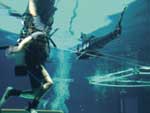Spy-fish to reveal secrets of the sea
Published: 28 November 2006
Staff at Glasgow University are developing a robotic fish which could allow researchers closer access to life underwater
A Glasgow University research team led by Dr Euan McGookin is developing a robot that will look and swim like an actual fish. This technology could have implications for both the environment and defence sectors.
The robot uses a 'bio-mimetic propulsion system' which imitates methods found in nature - in this case a fish tail instead of conventional propellers. With this method of propulsion the robot more closely mimics the biological swimming behaviour of real fish. Without propellers the robot will cause fewer disturbances while swimming and thus cause less damage to the surrounding environment.
Glasgow University researcher Chris Watts explains: "One application of the robot would be the monitoring of fish species to obtain a greater understanding of their behaviour. For example, we are currently developing a prototype of a robotic salmon which will help solve questions such as, what circumstances cause salmon to use fish ladders at a particular time? The salmon robot will be fitted with sensors which can track changes in water flow which it is thought might be one factor in the salmon's decision. Other equipment can be applied to the robots for specific purposes, including cameras"
This technology was also used for the Glasgow University entry in the Student Autonomous Underwater Challenge ヨ Europe (SAUC-E) organised by the Defense Science and Technology Laboratory (DSTL) earlier this year. The team developed a vehicle called SHARC (Submersible Hybrid Autonomous Rover Craft) that mimics the swimming behaviour of a shark. Both the tail and body sections closely resemble a shark with the addition of vertical thrusters to make the vehicle dive. As a result of the novel design the team won £500 for the team who took the most challenging approach.
Dr Euan McGookin, lecturer in Aerospace Engineering, said: "We wanted to create something that looked and moved just like a real fish. This is of particular interest to the underwater vehicle industry as without propellers the shark would be more efficient than conventional underwater craft"
Kate Richardson (K.Richardson@admin.gla.ac.uk)
1. For more information please contact the University of Glasgow?s Media Relations Office on 0141 330 3683 or email K.Richardson@admin.gla.ac.uk
2. For more information on the DSTL competition and the SHARC project please visit: http://www.mod.uk/DefenceInternet/DefenceNews/PeopleInDefence/SauceProvesToBeAnUnderwaterCompetitionWithADifference.htm
3. The robot fish is made of a plastic frame covered in a flexible latex covering to provide waterproofing. Within the plastic frame is an enclosure which contains the control electronics and servo motor which drives the tail propulsion system.
The SHARC vehicle has been constructed from as many readily available materials as possible due to the SAUC-E Competition rules which state that extra points are available for using everyday items. The main hull is made from a PVC sewage pipe, the head from shaped car fibre glass and the tail from bespoke mechanical parts waterproofed by latex coated ladies tights.
First published: 28 November 2006
<< November


